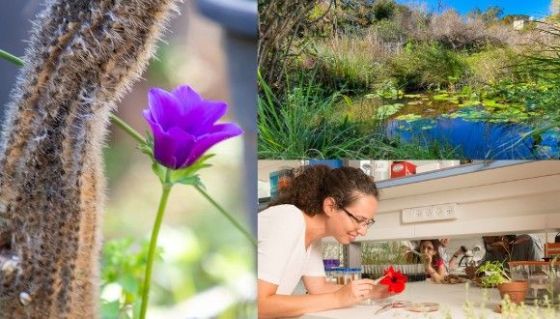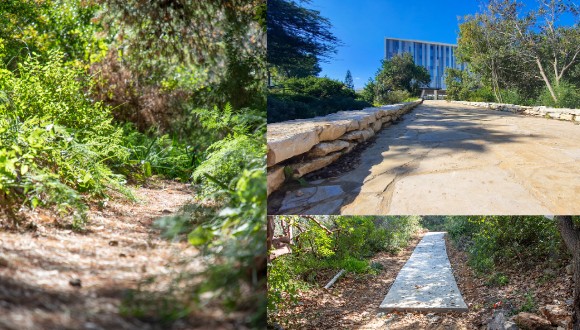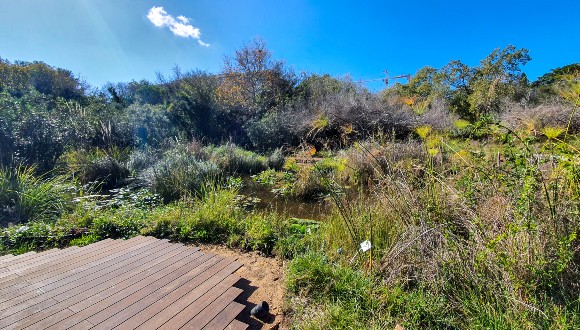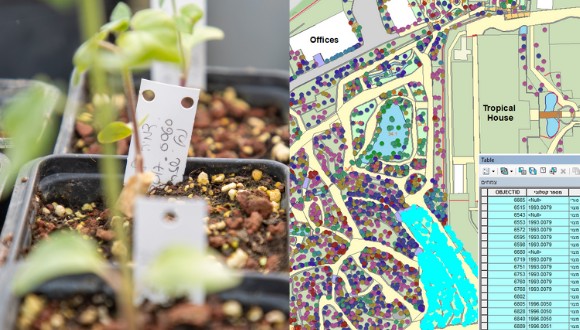
Tel Aviv’s Ecological Oasis: The Yehuda Naftali Botanic Garden at TAU
A donor-supported renovation focuses on research, facilities and visitor access.
By Lindsey Zemler
TAU’s Yehuda Naftali Botanic Garden is a Tel Aviv oasis for all, a collaborative research hub for plant scientists, engineers and neuroscientists, as well as a beautiful urban nature site that welcomes schoolchildren, soldiers and the general public and numbers among the city’s top tourist attractions.
In the last few months, the Garden has been undergoing a massive rejuvenation and enhancement program.
“Thanks to the generous support of Mr. Yehuda Naftali, this long-awaited renovation marks a significant step forward in our mission to be at the cutting edge of botanical research, education and conservation in Israel,” says Prof. Abdussalam Azem, Dean of the George S. Wise Faculty of Life Sciences, to which the Garden belongs. “This project brings us to the next level in improving infrastructure and access.”

Path construction in progress. Photo: Rafael Ben-Menashe.
A priority in planning the renovations, which are almost complete, was to increase access to all corners of the 34-dunam (8-acre) site, including to school groups, families, researchers, and students. This involved making the paths easier to navigate with wheelchairs, strollers, or groups.
Upon entering, the visitor will enjoy seeing native flora in the new beds adjacent to the garden’s western boundary fence, which are placed according to where they are found in Israel, from north to south. The acacia tree planted by Mr. Naftali at the Garden’s inauguration in 2019 can be found there, growing nicely.
 A variety of paths throughout the Garden. (Left): A natural blanket of pine needles is reminiscent of a walk through the Carmel Forest. Photos: Rafael Ben-Menashe.
A variety of paths throughout the Garden. (Left): A natural blanket of pine needles is reminiscent of a walk through the Carmel Forest. Photos: Rafael Ben-Menashe.
The main pathways are wide, paved and comfortable for walking in groups. Smaller paths branch out among various habitats to allow visitors an immersive nature experience. They are all designed to emulate natural processes; sometimes a section is left unpaved for water flow.
 Water pond with newly added wooden deck. Photo: Moshe Bedarshi.
Water pond with newly added wooden deck. Photo: Moshe Bedarshi.
Rainfall naturally flows downhill and arches in a waterfall to fill a pond, where the addition of wooden decks allows the visitor to stand comfortably at the edge of the water to view wetland plant species.
“When we planned the renovations, we put a lot of thought into the best visitor experience: to create a feeling of being transported to a nature reserve and being able to experience it from close range,” explained Kineret Manevich, Public Outreach Coordinator of the Garden.
.jpg)
New irrigation control center (left) and irrigation pipe (right) in the pine forest habitat. Photos (left) by Rafael Ben-Menashe and (right) by Moshe Bedarshi.
A new computer-controlled irrigation system is part of the critical infrastructure changes in the renovation plan. A large, complex network of pipes provides thousands of plants with essential water.

(Left): Rare plants being cared for in the nursery and (right) image of geo-mapping software. Photo (left) by Rafael Ben-Menashe and (right) courtesy of the Botanic Garden.
The Garden is also an active research center, where every plant is mapped and monitored, creating a robust database of botanical research. In addition, rare plants are rehabilitated and returned to nature.

The Garden offers a complete sensory experience, full of texture, color and shapes.
The area is a living ecosystem providing refuge to plants, animals, and of course, humans seeking nature without leaving Tel Aviv. The Yehuda Naftali Botanic Garden will be open to the public, and together with the adjacent Steinhardt Museum of Natural History will welcome visitors of all kinds.
